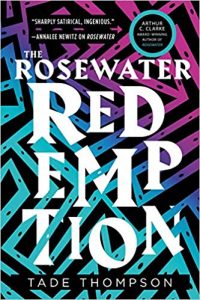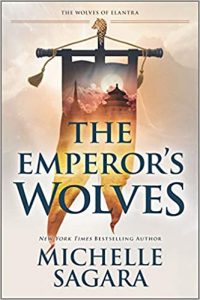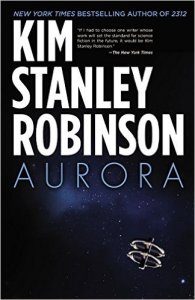Ian Mond and Gary K. Wolfe Review The Rosewater Redemption by Tade Thompson
 The Rosewater Redemption, Tade Thompson (Orbit 978-0316449090, $16.99, 416pp, tp) October 2019.
The Rosewater Redemption, Tade Thompson (Orbit 978-0316449090, $16.99, 416pp, tp) October 2019.
I wasn’t expecting the third book in Tade Thompson’s Wormwood Trilogy to be released so soon after the second, The Rosewater Insurrection. Not that I’m complaining. I’ve been eager to find out how Thompson would resolve the numerous threads he left dangling at the conclusion of The Rosewater Insurrection. The relatively short lead time between the second and third book also means I actually remember (well mostly) where things left off. As an aside, over the last few months it’s been lovely to see Rosewater, the first book in the trilogy – initially published by Apex in 2016 before it, and the series, was picked up by Orbit in 2018 – be nominated for and win a clutch of awards, including the Arthur C. Clarke and the Nommo.
The Rosewater Redemption begins on a pleasing note with the return of the Bicycle Girl – also known as Oyin Da – a mysterious time-traveller and by far Rosewater‘s most memorable character. I was a little sad when she made only a couple of enigmatic (though in retrospect important) appearances in The Rosewater Insurrection. In this book, Oyin Da takes on the role of narrator, explaining that while she’s the “wrong person to tell this story” because she’s “not at all objective… [and] may even change some facts to make [herself] more relatable” we should still follow her closely as “there will be turns, sudden shifts of perspective, [and] hurricanes without warning.” Her story begins just after the tumultuous climax of The Rosewater Insurrection, with the newly independent city-state barely holding together. Mayor Jack Jacques’s uneasy alliance with the Homians and their representative Koriko – the only thing keeping the Nigerian Army from overrunning Rosewater – comes under threat when disturbing revelations arise about the reanimates. It transpires that the city’s version of the walking dead, which the aliens use as a vessel for downloaded Homian minds, might retain a fragment of the original person’s consciousness. In the meantime, Jacques’s head of security, the kick-arse Aminat, Kaaro’s girlfriend and the standout character of The Rosewater Insurrection, is fighting a losing battle against rival gangs who seem hell-bent on turning the city into a war zone. She also has to contend with the Synners, Homian terrorists who delight in the slaughter of humans to quicken the transfer of minds into bodies. Working in the shadows, where she’s most comfortable, is everyone’s favourite S.45 agent, the brilliant and ruthless Femi Alagomeji, recently released from prison and now collaborating with Kaaro and Oyin Da to find a method of ending the Homian invasion once and for all.
As you’d expect from the concluding book in a trilogy, Thompson starts the novel at 11 and cranks things up from there. It’s not just a blur of action-packed set-pieces, although there are enough of those to make the special effects supervisor of a tent-pole film blush. Thompson finds room for a gripping courtroom drama that questions the definition of life in a world where death is put on hold. Thompson also offers a unique take on time travel that broadens our understanding of the xenosphere, more than just a psychic internet comprised of fungal spores, but also a Jungian storehouse of memories that can be accessed and even modified. As fascinating and breathless as all this is, it’s Thompson’s social and political awareness that sets the novel, and trilogy, apart from your average high concept science fiction blockbuster. In particular, there’s this touching subplot involving Rosewater’s (and for that matter Nigeria’s) first-ever Pride march. It comes about because Jack Jacques, for all his Machiavellian plans, boldly makes Rosewater a safe haven for the LGBTQIA community. The parade (small in size) occurs late in the novel, and although the city-state is literally crumbling around them, the group continues to march. “I’m not going anywhere,” explains a judge forced to hide his true nature on pain of imprisonment or death. “Do you know how many years I have waited for this? No. I’m going the full route, even if it kills me.” Thompson’s willingness to discuss the persecution of minorities in Nigeria also allows him to draw a firm line between asylum seekers (gay and trans folk) and colonisers (Homians) – a distinction that’s been blurred by the alt-right who have cast refugees and immigrants in the role of invader.
The ending of The Rosewater Redemption, and the series, is morally and ethically fraught; it has a hint of Independence Day about it, and is something I refuse to spoil even if I’m deeply conflicted about the resolution. But that’s what makes Thompson’s Wormwood trilogy so exciting. There are no bromides here, no easy solutions or pat endings, but rather a narrative structured around difficult choices made by a group of well-rounded, yet flawed characters. Just the sort of intellectually satisfying story, with its fair share of violence, big explosions, and most importantly people of colour, that in this post-Black Panther world, would be perfect for the big or small screen.
-Ian Mond
[This review and more like it in the October 2019 issue of Locus.]
Rosewater, the first volume of Tade Thompson’s Wormwood Trilogy, was viewed by many, including myself, as a first-rate example of this decade’s version of cutting-edge SF – morally complex (and sometimes compromised) characters, a strikingly original setting, smart political subtexts, and some really cool rethinking of the whole idea of alien invasion. Of course, when the first volume of a trilogy is so cutting-edge, the problem you face with subsequent volumes is what to do with the edges that you’ve just cut. In the case of Rosewater Insurrection, Thompson rather cleverly moved in several directions at once, ramping up the stakes (which we expect in the second volume of a trilogy), shifting the narrative toward more conventionally violent adventure, foregrounding different characters, and deepening the political themes. Under the guidance of an ambitious mayor, Rosewater – the district of Nigeria which became the epicenter of a bizarre alien presence called Wormwood – decided to declare its independence from Nigeria, leading to a conflict that was further complicated by the increasingly ominous intentions of the aliens behind Wormwood. What had started as an alien presence tale became much more clearly an alien invasion tale. In Rosewater Redemption, Thompson ramps up the invasion narrative once again. The compromise worked out at the end of Rosewater Insurrection is beginning to fall apart, and it morphs into an all-out, us-or-them war of survival and annihilation.
(A word of caution for spoilerphobics: you can’t meaningfully discuss what happens in the third volume of a trilogy without revealing details from the first two volumes.) The aliens (or “Homians”), it seems, facing the death of their home planet, had already committed a form of auto-genocide by uploading themselves into what on Earth comes to be called the xenosphere, a kind of fungal internet that, among other things, can repair or even resurrect the bodies of anyone within range. Those resurrected bodies could theoretically provide homes for the downloaded alien intelligences – except now the question arises as to whether those dead human minds are really dead. One of the more provocative scenes in Rosewood Redemption is, of all things, a brief courtroom drama in which the wife of that Rosewood mayor argues that at least remnant personalities – think traumatic brain damage – are still present in the bodies the aliens plan to inhabit. And, of course, there’s the question you always have to ask of any apparently friendly aliens, which is, what’s the real endgame? Between gang wars and mass murders, the question quite reasonably arises as to whether humans are dying at a fast enough clip for the aliens’ purposes. At one point, a harebrained scheme to defeat the aliens seems lifted wholly from Independence Day. For much of the novel, there are oddly disturbing echoes of the “you will not replace us” rhetoric of intolerance – but then, I suppose those echoes are detectable in alien invasion stories going all the way back to War of the Worlds.
Among the sometimes daunting shifts of point of view, familiar characters from the first two novels reappear, including the psychically “sensitive” Kaaro, now retired; his wife, the security chief Aminat; the Rosewood mayor Jack Jacques (who gains in complexity here); and the mysterious time traveling “bicycle girl” Oyin Da, who gets the only first-person point of view, and who makes a startling discovery about herself. There are also some interesting secondary characters, such as Jacques’s assistant Lora, the older sensitive Nike (who more or less lives in Kaaro’s head), Kaaro’s former intelligence boss Femi, the god-like Koriko who serves as the main link between Earth and the Homians homeworld, the superhacker Bad Fish (perhaps the most colorful character here), and several others. Between all these viewpoints, the need to answer mysteries left over from the first two volumes (such as what happened to America, which we learn when Oyin Da visits there), and subplots involving an effort to grow an empty brain in the lab, an eerily accurate 19th-century prophecy, and even Jacques’s effort to decriminalize homosexuality, there’s an occasional sense of overpacking, as though, after building a magnificent Lego castle, Thompson needed to find places to fit in all the leftover pieces. Fortunately, those pieces are pretty interesting in their own right, and the completed trilogy, if a little messy, is as impressive a castle as the first two volumes led us to hope it would be.
-Gary K. Wolfe
[This review and more like it in the November 2019 issue of Locus.]
Ian Mond loves to talk about books. For eight years he co-hosted a book podcast, The Writer and the Critic, with Kirstyn McDermott. Recently he has revived his blog, The Hysterical Hamster, and is again posting mostly vulgar reviews on an eclectic range of literary and genre novels. You can also follow Ian on Twitter (@Mondyboy) or contact him at mondyboy74@gmail.com.
Gary K. Wolfe is Emeritus Professor of Humanities at Roosevelt University and a reviewer for Locus magazine since 1991. His reviews have been collected in Soundings (BSFA Award 2006; Hugo nominee), Bearings (Hugo nominee 2011), and Sightings (2011), and his Evaporating Genres: Essays on Fantastic Literature (Wesleyan) received the Locus Award in 2012. Earlier books include The Known and the Unknown: The Iconography of Science Fiction (Eaton Award, 1981), Harlan Ellison: The Edge of Forever (with Ellen Weil, 2002), and David Lindsay (1982). For the Library of America, he edited American Science Fiction: Nine Classic Novels of the 1950s in 2012, with a similar set for the 1960s forthcoming. He has received the Pilgrim Award from the Science Fiction Research Association, the Distinguished Scholarship Award from the International Association for the Fantastic in the Arts, and a Special World Fantasy Award for criticism. His 24-lecture series How Great Science Fiction Works appeared from The Great Courses in 2016. He has received six Hugo nominations, two for his reviews collections and four for The Coode Street Podcast, which he has co-hosted with Jonathan Strahan for more than 300 episodes. He lives in Chicago.
 While you are here, please take a moment to support Locus with a one-time or recurring donation. We rely on reader donations to keep the magazine and site going, and would like to keep the site paywall free, but WE NEED YOUR FINANCIAL SUPPORT to continue quality coverage of the science fiction and fantasy field.
While you are here, please take a moment to support Locus with a one-time or recurring donation. We rely on reader donations to keep the magazine and site going, and would like to keep the site paywall free, but WE NEED YOUR FINANCIAL SUPPORT to continue quality coverage of the science fiction and fantasy field.







